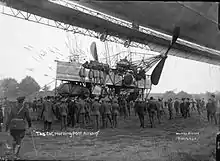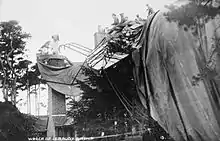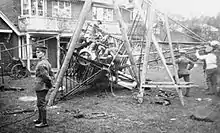Lebaudy Morning Post
The Lebaudy Morning Post was a French semi-rigid airship built for the British Army in Moisson, France, by manufacturers Lebaudy Frères. The airship was commissioned by the newspaper The Morning Post, who created a fund to purchase the airship and present it to the British Army. The airship's envelope was damaged on the delivery flight and then it was destroyed on a subsequent trial flight after repair. At the time of construction it was the largest airship that had been built in France.[1]
| Morning Post | |
|---|---|
 | |
| Type | Military reconnaissance airship |
| Manufacturer | Lebaudy Frères, Moisson, France |
| First flight | September 1910 |
| Owners and operators | British Army |
| In service | 1910-1911 |
| Last flight | May 1911 |
| Fate | Destroyed |
Design and development

The Morning Post was designed by Henri Julliot to the same principles as the earlier Lebaudy République and Lebaudy Patrie but was larger and faster.[2] The envelope was made of panels of waterproof canvas with two valves at the bottom to allow the hydrogen to be released, either automatically or by hand.[2] An additional manual valve on the top of the envelope could be used to completely deflate the envelope.[2] Two long quick-release panels were also built into the envelope for emergency deflation.[2] The gas bag had three ballonets, one at the front, one in the centre and one at the rear: the front and rear ballonets could be used to fly the airship up or down.[2] Two centrifugal fans were used to inflate the ballonets.[2] Small fixed vertical and horizontal stabilisers were mountes at the rear of the envelope.
Suspended below the envelope a diamond-section keel constructed from steel tubing extended nearly the whole length of the envelope. This contained a horizontal stabilising surface for the front two-thirds of its length: the rear part also had a fixed vertical surface. It carried two pairs of elevators, one pair forward and the other aft, and a single rear-mounted rudder.[1] Below this the car, also made from steel tubes was suspended. This had a single landing pivot in the bow.[2] and was divided into compartments and could carry 20 persons.[2] Also inside the car were two Panhard four-cylinder water-cooled piston engines rated at 135 hp, driving a pair of two-bladed pusher propellers through clutches and a gearbox.[2] The propellers, which rotated in opposite directions, were 16 ft 5in (5 m) in diameter and revolved at about one third of the engines' speed.[1]
Operational history
The airship made its first flight on 14 September 1910[3] and this was followed by a series of test flights before it was formally accepted by the Army.
Delivery flight
The Morning Post left Moisson on delivery to Farnborough at 10:15 in the morning of 26 October 1910, carrying eight people including the pilot Louis Capazza and three passengers: the designer Henri Julliot, the newly appointed commander of the Army Balloon School Major Sir A. Bannerman, and a representative of the Morning Post.[4] By two o'clock it had reached Brighton on the English southern coast, it then travelled north over Horsham towards Aldershot.[2] It soon approached North Camp at Farnborough for an attempted landing on the common close to the Army Balloon Works.[2] Due to the strong winds it took a number of approaches to the common before troops managed to grab the ropes and secure the airship.[2] The airship was towed to a balloon works shed specially built to house it. It was soon realised it would be a close fit but as it had been measured to fit for the Morning Post all that was required was that care was taken in moving the airship into the shed.[2] With all but ten feet inside the shed, a large hiss was heard as the envelope had caught on a girder.[2] A number of troops were under the airship as it collapsed but nobody was hurt.[2]
Final flight


On 4 May 1911 the Morning Post was on its first flight since being damaged in October 1910 when it was delivered.[5] The airship with a crew of seven was at the end of the one-hour trial flight, it had deployed ropes to allow the soldiers on the ground to bring the ship to the ground, the men could not hold it.[5] The airship drifted into some trees and the envelope burst, causing the airship to collapse over the trees and a house.[5] One of the French mechanics was badly burned but all the crew were rescued from the debris.[5]
Specifications
Data from [2]
General characteristics
- Capacity: 20
- Length: 337 ft 10 in (103 m)
- Diameter: 39 ft 4 in (12 m)
- Volume: 353,168 cu ft (10,000.6 m3)
- Powerplant: 2 × Panhard & Levassor 4M 4-cyl. in-line water-cooled piston engines, 135 hp (101 kW) each
- Propellers: 2-bladed 2x Chauvière Integrale, 16 ft 5 in (5.00 m) diameter (two propeller shafts driven by one engine)
References
Notes
- "La Dirigeable "Morning Post". l'Aérophile (in French): 563–5. 15 December 1910.
- "The "Morning Post" National Fund Airship". Flight: 769. 24 September 1910.
- "La Dirigeable "Morning Post Traverse La Manche". l'Aérophile: 522. 15 November 1910.
Bibliography
External links
![]() Media related to Morning Post (airship) at Wikimedia Commons
Media related to Morning Post (airship) at Wikimedia Commons